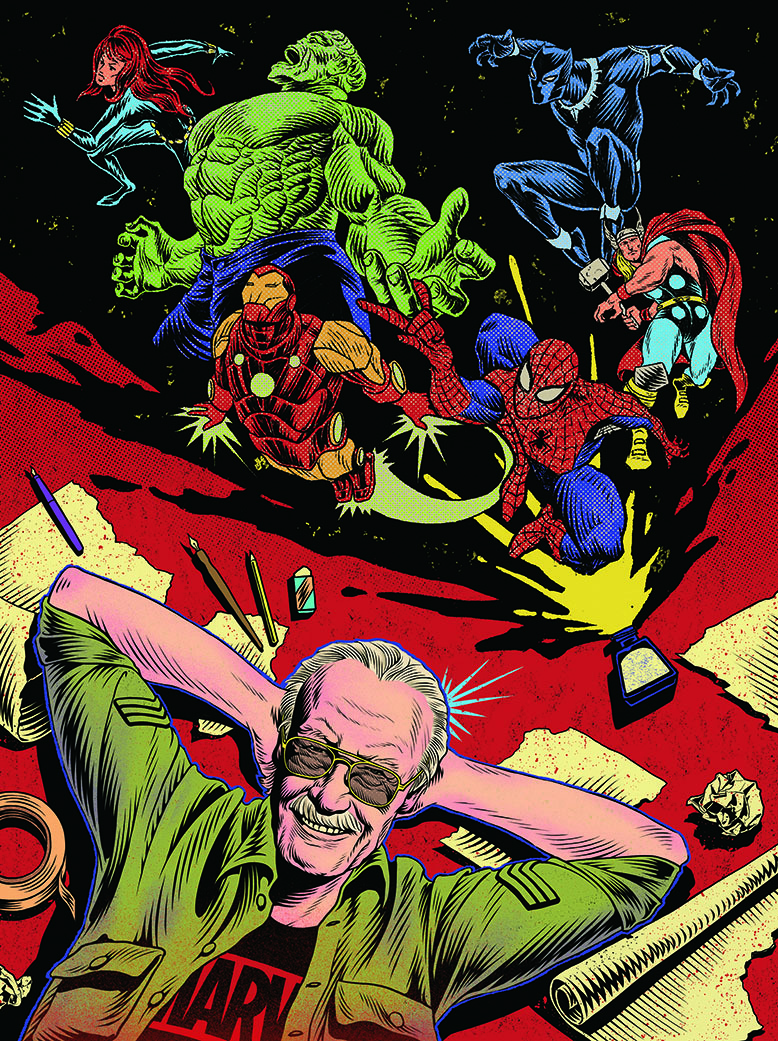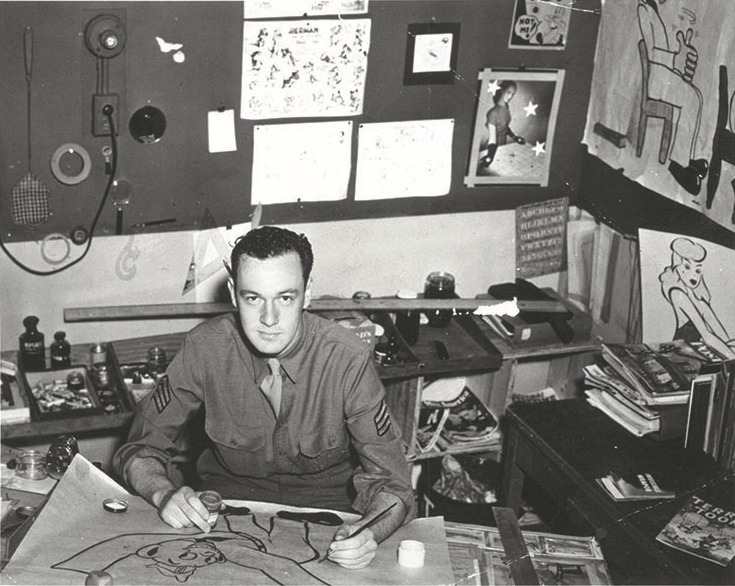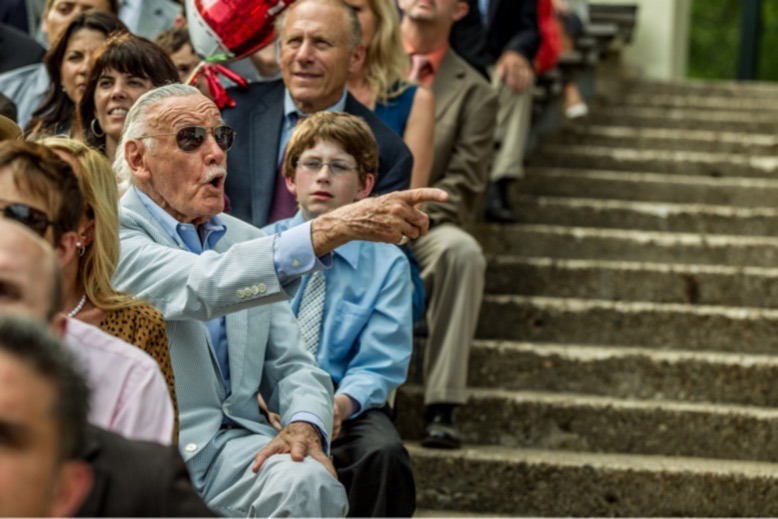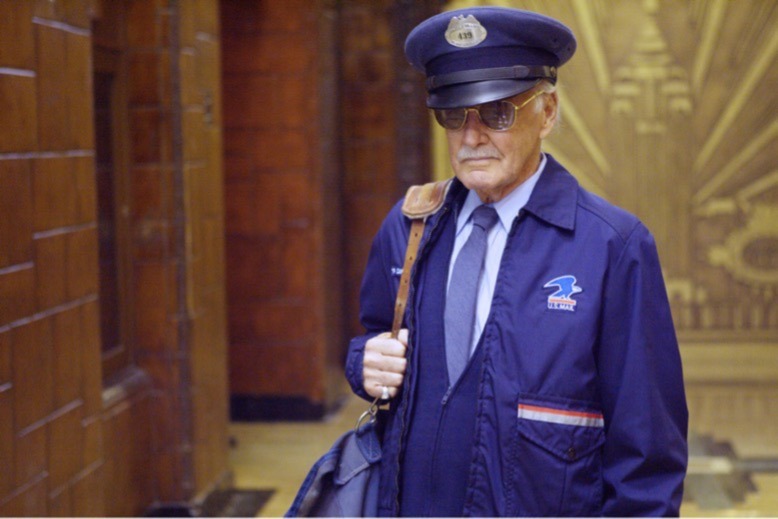
Illustration by Yiran Jia
Long before he was the center of the Marvel Comics Universe (MCU), Stan Lee was just another 19-year-old at Fort Monmouth for basic training—as Lee quipped, “Guarding New Jersey from an impending enemy invasion”—shortly after enlisting in November 1942.
Lee was initially “put on sentinel duty overlooking the Atlantic,” according to Abraham Riesman’s 2021 book, True Believer: The Rise and Fall of Stan Lee, “freezing his tuchus off in what he assumed was a kind of official hazing ritual.”
But this soon became an important moment in Lee’s early career. “This was an eye-opening experience,” another Lee biographer, Bob Batchelor, tells New Jersey Monthly. “His time at Fort Monmouth exposed [Lee] to recruits and draftees from all over the country….It broadened his ideas about storytelling.”
At the time, of course, there was “no way Stan could have known his military service would have any direct impact on his writing,” Riesman notes in True Believer.
Ultimately, though, Lee (who died in 2018) learned valuable lessons during his time at the Jersey Shore, on his way to creating icons such as Spider-Man, Iron Man and Black Panther, who have since come to dominate American popular culture—thanks in no small part to another show business titan with Garden State ties.
Kevin Feige—a graduate of Westfield High School—has served as a top producer on three dozen MCU blockbusters in the last two decades, including the latest entry, Black Panther: Wakanda Forever, which hit theaters in November.
Ultimately, by one estimate, the collective labor of Stan Lee, Kevin Feige, and MCU’s army of musclebound heroes and evil villains has generated worldwide revenues of nearly $30 billion, “making it the biggest movie franchise ever,” according to Business Insider.

Stan Lee entered the U.S. Army in early 1942 and served as a member of the Signal Corps after basic training in Fort Monmouth.
MCU fans have even glimpsed the Garden State in several recent blockbusters. A fictional Jersey military base plays a pivotal role in 2011’s Captain America: The First Avenger as well as Avengers: Endgame, the 2019 flick that is now the highest-grossing film of all time. Meanwhile, the Disney+ TV show WandaVision is set in the (real) North Jersey town of Westview.
Marvel also returned to Jersey this past summer with a new take on Ms. Marvel—Kamala Khan, a character first introduced in the 1960s as an Air Force officer and female counterpart to (then male) Captain Marvel.
In 2013, the Ms. Marvel comics character was reimagined by a creative team including Jersey natives Sana Amanat and G. Willow Wilson as a Muslim American teen, who now stars in her own Disney + TV series.
“Ms. Marvel is a new kind of superhero,” head writer and executive producer Bisha K. Ali says. “I never saw a young teenager of color—specifically a Pakistani—in a comic book. Are you kidding?”
As Kamala Khan herself put it in one episode: “It’s not usually the brown girls from Jersey City who save the world.”
***
Marvel’s setting was a homecoming, of sorts, for Stan Lee, who would have turned 100 years old this December. He was born Stanley Martin Lieber, a short stroll from the New York-New Jersey waterfront, in December 1922.
His parents, Jack and Celia, were working-class Jewish immigrants who raised Lee, as well as his younger brother, Larry, on Manhattan’s West End Avenue, and later, in the Bronx.
Though he would eventually earn fame and fortune in the visual world of comic book art, Lee was actually more of a word nerd growing up—a “nut for reading,” as Riesman writes. Young Stan devoured everything from Shakespeare and Mark Twain to Leo Edwards’s once-popular Poppy Ott children’s series.
Lee had an uncle on his mother’s side who worked in the up-and-coming comic book industry. After graduating high school at the age of 16, Lee took his facility with narrative structure to the offices of what was then known as Timely Comics (later morphing into Marvel Comics).
By the late 1930s, Adolf Hitler was rattling sabers across Europe. This was reflected in a new Timely character—Captain America—introduced in March 1941.
“Lee had already been heavily influenced by working on the early Captain America comics. Many had Nazis on the cover as villains,” notes Batchelor, whose updated Lee biography, Stan Lee: A Life, was rereleased in October.
When Pearl Harbor was attacked in December 1941, Lee did not wait to be drafted.
“I felt I had to go in the army,” Lee wrote in his 2002 autobiography, Excelsior. “I used to go to penny arcades…and shoot those little guns and win prizes all the time—I figured I was a shoo-in to handle real guns.”
But frostbite, not firearms, was a bigger concern once Lee was posted in Jersey.
“My first assignment at Fort Monmouth was to stand guard duty at night, there in sight of the Atlantic Ocean,” Lee recalled. “Once the sun went down and the frigid wind came up, I turned into one human ice cube of a sentry.”
When he was finally able to leave his icy post, Lee raced back to the barracks “so fast I almost caused a sonic boom.”
Lee was eventually selected to serve in the Army’s communications wing—the Signal Corps. And while he was only at Fort Monmouth long enough to endure the rigors of basic training, the experience left a deep impression on Lee, according to biographers.
“Fort Monmouth was a big, austere base, and well-known as a research facility,” says Batchelor. “Think about it—radar, the most innovative communications equipment—all from this base in New Jersey!”
Lee’s subsequent military postings would keep him far from the front lines. But his storytelling instincts were stirred up nonetheless.
Lee was, as Excelsior puts it, “fired up with excitement, anticipating the adventure of climbing telephone polls and splicing wire under fire.”
Lee was starting to “see things in comic book form,” he wrote.
***
Army higher-ups later tapped Lee as “one of only nine men assigned to the [Signal Corps’] so called playwright division,” charged with educating soldiers about everything from equipment to morale.
“When he wrote training manuals or used cartoon images to educate users on a piece of delicate equipment,” Batchelor notes, “Lee thought about all those different men and how he could best reach them.”
Also part of Lee’s job was building morale—propaganda.
“Stan Lee was a hype man!” says Riesman with a laugh. “His job was about salesmanship. Salesmanship. Mission purpose. Camaraderie.”
[RELATED: Stan Lee Was ‘A Big Fan’ of DC Comics Competitor Joe Kubert]
This instinct for hype—mixed in with heaping doses of creativity, exaggeration and occasional outright lies—served Lee well after the war as he rose through the comic book industry, cultivating a madcap persona, at once eccentric and approachable.
And prolific.

Lee makes a cameo in 2014’s The Amazing Spider-Man 2, something he did in most Marvel films prior to his 2018 death. Photo: Columbia Pictures/Photofest
In the early 1960s, Lee and frequent collaborator Jack Kirby unveiled the Fantastic Four, followed by the Incredible Hulk, the X-Men, Daredevil, Iron Man and more. Thus began a thrilling run of creativity—and financial success—that was interrupted at times by shifts in cultural taste, but has dominated the 21st century.
Alongside all of the acclaim, however, were never-ending emotional and legal disputes about who actually deserved most of the credit—and cash—for these comic creations. Right up until Lee’s 2018 death, having earned and also lost hundreds of millions of dollars, Lee was entangled in legal and financial disputes, amid charges that a onetime business associate was essentially imprisoning the 95-year-old Lee in an elaborate effort to steal his money.
***
Such sensational heights of fame seemed unlikely right after Stan Lee left Fort Monmouth and joined artists such as Theodore “Dr. Seuss” Geisel and Mr. Smith Goes to Washington director Frank Capra in the Signal Corps. Another Signal Corps member was a talented illustrator from Westfield, New Jersey, named Charles Addams, whose ghoulish cartoons for the New Yorker evolved into a television and movie franchise still with us today.
In a movie landscape decimated by Covid-19, 2021’s Addams Family 2 raked in $125 million. Not bad at all. But not in the same (if you will) universe as the Marvel/Stan Lee flick SpiderMan: No Way Home, which has thus far earned nearly $2 billion across the globe.

Lee popped up as Willie Lumpkin in the 2005 flick Fantastic Four. Photo: 20th Century Fox/Photofest
In the not-too-distant future, when you watch an Addams Family reboot or a new superhero streaming series, it might have its own Fort Monmouth connection.
Stan Lee’s onetime basic training site was shut down in 2011. Since then, local officials have tried to sell developers on potential uses for the 300-acre site. Earlier this year, Governor Phil Murphy pronounced himself “thrilled” that Netflix was planning to turn the old Army base into a state-of-the-art film-production facility.
[RELATED: Inside New Jersey’s Thriving Film and TV Industries]
Which could be seen as yet another homecoming, of sorts, for Stan Lee. Whatever his actual role in the big bang that created the Marvel Universe, it was substantial and important. Another bookish kid with deep connections to Jersey, Pulitzer Prize-winning author Junot Diaz, once wrote: “If Western popular culture has a common idiom, a force that binds us all, the stories contained in Marvel Comics are probably it. In a few short decades…[they have] rewired how millions, perhaps even billions, of people imagine what is possible, what is heroic, what is good.”
All of which suggests that Stan Lee used a lot more than his tuchus during his chilly stint at the Jersey Shore.
Tom Deignan is a Woodbridge resident and regular contributor to New Jersey Monthly. He has written for the Washington Post and New York Times and is researching a book about Ellis Island.
No one knows New Jersey like we do. Sign up for one (or more!) of our newsletters to get the best of where we live sent to your inbox every week. Want a print magazine mailed to your home? Purchase an issue from our online store.



